2009 Salary Survey: Salaries and Stress on the Rise
LCGC assistant editor Megan Evans discusses this year's salaries and trends in employment for spectroscopists.

The average salarym age, workload, and stress level increased this year, while the gender earnings gap remains stagnant.
Despite the difficult economy and burgeoning unemployment rate, the average spectroscopist's salary has increased from last year. This year's 598 respondents had nearly two years more experience than last year's respondents, which might explain the salary increase.
Before we delve into the salary breakdowns, here are a few statistics about this year's survey:
- The average age of all respondents is 48.9 years. The average age of male respondents is 50.5 years, and 44.0 years for females.
- Respondents have 21.8 years of professional experience, on average, and 8.7 years of experience in their current position.
- 89% of respondents are employed full-time; 3% are postdoctoral researchers/graduate students; 3% are employed part-time; and 2% are unemployed.
- 58% of respondents work in the private sector; 21% work in academia; and 16% work in government/national labs.
- 19% of respondents are senior scientists/researchers/research fellows; 17% are chemists/spectroscopists; and 14% are laboratory directors/managers.
- 28% of respondents specialize in applied research/development; 15% in general testing and analysis; and 11% in quality control/assurance or validation.
- 82% of respondents' employers cover the cost of conferences and web seminars.
- 59% of respondents' companies offer in-house training.
- 48% of respondents say their stress level at work has increased over the past year; 5% say it has decreased; 46% say it is the same.
- 3% of respondents hold associate degrees, 35% hold bachelor's degrees, 21% hold master's degrees, and 38% hold doctoral degrees.
- 54% of respondents have their highest degree in chemistry and 9% in biology.
- 75% of respondents are male and 25% are female.
- 27% of respondents live in the Midwest; 25% in the Northeast; 23% in the Southeast; 21% in the Southwest; and 4% in the Northwest.
Salaries on the Rise
According to this year's survey, the mean salary for all respondents is $78,807, which is up from last year's mean of $77,634— a small increase of $1,173. However, this is the second highest salary since 2007 (see Table I).
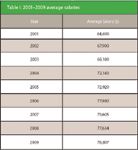
Table I: 2001â2009 average salaries
One significant demographic difference that could help explain the rise in this year's survey was the increase in professional years of experience (21.8 years) compared to last year (19.9 years). This is a slight change, but typically more professional experience means a higher salary. An estimated 40.3% of respondents had between 21 and 35 years of experience; 15.1% had between 10 and 15 years of experience; 12% had between 16 and 20 years of experience; 9.5% had between 5 and 9 years of experience; 9.3 had less than 5 years of experience; 7.7% had between 36 and 40 years of experience; and 6.2% had 41 or more years of experience.
Gender Equality?
Not straying too far from last year's results, the gender earnings gap is still significantly wide. According to the survey, composed of 75% males and only 25% females, males are earning $82,767 and females are earning much less at $67,189. This is a gap of $15,578, which is smaller than last year's gap of $16,000, but still higher than the 2007 results of $14,218.
Still continuing the trend from previous years, our 2009 survey found that males earn more than females at all levels of education (see Figure 1). Despite this, there were several major salary changes that have begun to close the huge divide in gender earnings. The largest difference in the study comes at the doctorate level, with males earning $96,972 and females earning $79,461, a gap of $17,511, which is nearly $10,000 more than last year's study. However, 55% of women with doctoral degrees have 15 years or less of professional experience; this may help explain the difference. At the associate's degree level, males earn $60,040 and females earn $45,500. On the plus side, it seems that females are closing this gap quite rapidly with a salary difference of only $14,540 compared to last year's margin of $21,000. For respondents with bachelor's degrees, males earn $71,215, whereas females earn $59,694. Again, the salary difference in this group is smaller than last year's, with a difference of only $11,521 compared to 2008's difference of $14,033. The smallest difference in salary comes at the master's degree level, with males earning $76,185 and females earning $68,603. This is a significant change from last year, with a difference of only $7,582. In the 2008 survey, females only earned $60,473 at the master's degree level and males earned $78,372, which was a difference of $17,889. This is the most significant change for equality in the gender earnings gap.
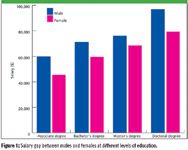
Figure 1
Not surprisingly, the gender salary gap is also present in each level of professional experience, except 36 to 40 years (see Figure 2). For respondents with less than five years of experience, males earn $50,536 and females $45,593, a difference of $4,943, which is up from last year's difference of $4,709. For those with 5 to 9 years of experience, males earn $67,317 and females earn $62,348, a difference of $4,969. The salary gap in this bracket has shrunk considerably from last year's difference of $10,299. With 10 to 15 years of experience, males are earning $77,666 versus females who are earning $74,043— a difference of $3,623, which is again, a big improvement from last year. The largest salary difference comes at 16 to 20 years of experience, with males earning $88,293 and females at $64,203, a startling difference of $24,090. At 21 to 35 years of experience, men earn $88,756 and women earn $78,442 — a difference of $10,314. Finally, females take the lead at 36 to 40 years of experience, earning $90,000 to males $88,969, a difference of $1,031. However, males take the lead once again at 41 or more years of experience, earning $84,079 to females $75,500, a difference of $8,579. Basically, it takes women much longer to reach the higher salaries that men can achieve with 16 to 20 years of experience. However, women are the only ones to reach the $90,000 salary mark in the study.

Figure 2
Sectors and Titles
Once again, the private sector was the largest employer, with 58% of respondents. Private sector employees reported an income of $85,666, which is slightly higher than the last two years. Respondents working in academia (21%) reported a salary of $62,264, which is higher than both the 2008 and 2007 studies. Finally, scientists working in government/national labs (16%) reported making $79,516, which is nearly $3,000 more than last year's survey (see Figure 3).
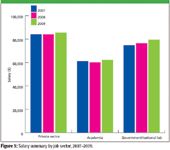
Figure 3
CEOs/presidents have taken a hard hit in their salaries this year, falling from $158,833 in 2008 to $115,375 this year. This large drop of $43,458 is the lowest salary reported for CEOs/presidents in recent years. Another professional group hit hard this year were the senior scientist/researcher/research fellows, who reported an income of $92,174, which is down from last year's $97,321 but still up from 2007's report of $91,041. Full professors reported a salary of $108,321 in 2009. The job specialties reporting the highest salaries are corporate management, with an income of $131,429, which is down from last year's $179,250. Project management is the second highest paid specialty job with an income of $100,771. This is up nearly $20,000 from last year's salary of $82,677. Finally, applied research/development has also seen a salary increase from last year's $82,001 to 2009's $87,965.
Can't Get No...Satisfaction
Our respondents seem to be satisfied in their positions, although stress levels and workloads are increasing. According to David W. Ball, professor of chemistry at Cleveland State University, Ohio, "It is obvious that the state of the overall economy is being reflected in the field of spectroscopy — workload and work-related stress is increasing, mostly due to staffing cuts. Despite this, however, job satisfaction still remains high (see Figure 4), suggesting that spectroscopy as a whole is still intellectually stimulating enough to attract quality people." This year's survey revealed that 47% of respondents are extremely or very satisfied with their current position (up from 42% last year), 42% are satisfied (same as last year), and 12% are not satisfied or not at all satisfied (down from 14% last year). The mean salary for respondents who claim to be extremely or very satisfied with their current position is $85,897, while those that are satisfied earn $74,476, and those who are not satisfied or not at all satisfied earn $66,808. Further research revealed that 42% of respondents are extremely or very satisfied with their current employer, 44% are satisfied, and 14% are not satisfied or not at all satisfied. The mean salary for those who are extremely or very satisfied with their current employer is $83,708, those who are satisfied earn $77,730, and those who are not satisfied or not at all satisfied earn $67,846.
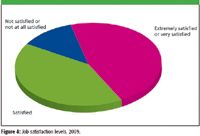
Figure 4
Even in these scary economic times, 17% of respondents are considering making a job change in the next year. The mean salary for those considering making a job change is $74,966, those who are not sure is $82,387, and those who are not considering a change is $73,738. Among the respondents considering a job change, 77% would prefer their new job to be in the private sector, 25% would prefer it to be in government, and 23% would prefer it to be at an academic institution. The top reasons for considering a job change are professional advancement (61%), income (52%), and intellectual challenge (45%). Among respondents with 5 years or more of professional experience, obtaining lasting and meaningful employment (66%), getting your first job (55%), advancing in the profession (41%), and mastering the regulations associated with the profession (39%) are more difficult now than they used to be.
No matter what industry you look into, most people will report an increase in workloads due to cutbacks at a lot of companies. This is surely the case in the spectroscopy field, as well, with 58% of respondents reporting their workload has increased over the past year, 7% reporting it has decreased, and 33% reporting it is the same. Among respondents whose workload has increased, the most common reasons for the increase are staffing cuts (48%), increased business (44%), and new equipment added to the lab (38%). The mean salary for those whose workload has increased is $80,181, stayed the same is $78,632, and decreased is $74,036.
According to our survey, 48% of respondents say their stress level at work has increased over the past year (same as last year's results), 5% say it has decreased (down from 6% last year), and 46% say it is the same (up from last year's 45%) (see Figure 5). Among respondents whose stress level has increased, the most common reasons for the increase are staff management uncertainty (54%), business uncertainty (46%), and negative workplace attitudes (34%). Among respondents whose stress level has decreased, the most common reasons for the decrease are improved workplace attitudes (40%) and continuing education (20%). The mean salary for those whose stress level at work has increased is $78,620, stayed the same is $79,510, and decreased is $82,365.
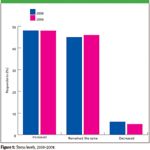
Figure 5
Finally, career advancement is a big factor for most of our respondents. Respondents say it will take an average of 3.6 years to make their next career step. According to our survey, 21% of respondents say retirement is their next career step, 16% say lab director/manager, and 5% say consultant. Furthermore, 31% of respondents say their companies are extremely or very supportive of their career advancement, 44% are supportive, and 25% are not supportive or not at all supportive.
Education Is Key
It should come as no surprise that most of our respondents have some degree in higher learning: 3% of respondents hold associate degrees, 35% hold bachelor's degrees, 21% hold master's degrees, and 38% hold doctoral degrees. According to the survey, 54% of respondents have their highest degree in chemistry and 9% in biology.
Continuing education is also very important for respondents to remain abreast of new technology and advancements in their fields. On average, respondents attend 1.9 conferences and 2.1 web seminars each year. According to our survey, 82% of respondents' employers cover the cost of conferences and web seminars. 37% of respondents say conferences and web seminars are needed for professional certification or career advancement. Also, 59% of respondents' companies offer in-house training. Among those respondents, the most common types of training offered by their companies are training courses (81%), seminars (69%), and tuition reimbursement (59%). Other common benefits offered by respondents' companies include 401(k) (74%), retirement plan (58%), and child care (10%).
Northeast Takes the Cake
For the first time in two years the Northeast has taken the title from the Southwest for the region with the highest annual income (see Figure 6). This year, the Northeast (25% of respondents) has an annual income of $85,593, up from last year's income of $82,926. The Southwest (21% of respondents) comes in second place this year, earning an annual income of $79,111. This is roughly $10,000 less than the last two years, but in the 2008 survey the region had 34% of respondents with bachelor's degrees, 20% with master's degrees, and 41% with doctoral degrees; this may help explain the notable salary decrease from 2008 to 2009.
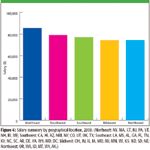
Figure 6
The Southeast (23% of respondents) is in third place this year with an annual income of $77,094, which is up from last year's $73,993. Last year's lowest salary region, the Midwest (27% of respondents), has bumped up to second place this year with a salary of $74,459, which is an increase from last year's salary of $70,040. Finally, the Northwest (4% of respondents) earned the least with a salary of $74,403, which is up from last year's salary of $73,135, but unfortunately not as high as the other regions.

Methodology
The data presented in this article are a small sampling of the spectroscopy community as a whole. If you would like to share your thoughts on this article, its data, or how it relates to your career, please email us at: spectroscopyedit@advanstar.com
